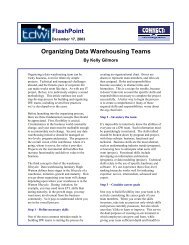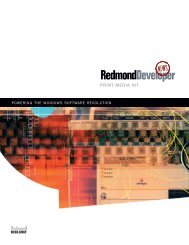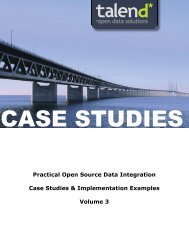BI SEARCH AND TEXT ANALYTICS - The Data Warehousing Institute
BI SEARCH AND TEXT ANALYTICS - The Data Warehousing Institute
BI SEARCH AND TEXT ANALYTICS - The Data Warehousing Institute
You also want an ePaper? Increase the reach of your titles
YUMPU automatically turns print PDFs into web optimized ePapers that Google loves.
<strong>BI</strong> <strong>SEARCH</strong> <strong>AND</strong> <strong>TEXT</strong> <strong>ANALYTICS</strong>a fairly advanced (and more costly) tool, and then devote far more development time than asimple implementation would require.• Complexity (49%) and cost (29%) are common concerns. Simple implementations of anenterprise search tool (where you install the engine on a server and point its crawlersat files and other sources) are straightforward and cheap, compared to other enterprisesoftware implementations. It’s the advanced implementations of search (which requirecustom development of lexicons, rules, and interfaces) that incur high complexity and cost.According to users interviewed in this research, integrating a <strong>BI</strong> platform with a third-partysearch engine is one of the highest risks. <strong>The</strong>refore, users should look to their <strong>BI</strong> vendorfor guidance, since many of the functions discussed here are available now (or will besoon) directly from the <strong>BI</strong> platform. If integrating an external search engine is desirable orinevitable, users should stick to the ones that the <strong>BI</strong> platform supports explicitly through adedicated interface.What reservations do you have about applying search in a <strong>BI</strong> context? (Select five or fewer.)Figure 10. 1,417 responses from 370 respondents. (3.1 responses per respondent)Defining the scope ofsearchable contentis basic to all searchimplementations,including <strong>BI</strong> search.<strong>The</strong> Scope of <strong>BI</strong> Search<strong>The</strong> list of files, documents, reports, and systems (and their component parts) indexed by a <strong>BI</strong>search implementation constitute its scope. <strong>The</strong> scope of the implementation determines manythings, including what’s visible through the search index (all else is invisible) and what elementsof the indexed source are included in the index (which influences how users search and howrelevant result sets are). This definition of scope applies to both simple and advanced searchimplementations, and scope in a well-planned implementation will start small and grow over time.Hence, defining scope for multiple project phases is one of the most important steps in planningany implementation of <strong>BI</strong> search.With scope in mind, TDWI Research asked, “What reports and documents should be searchable?”(See Figure 11.)• Users want to integrate multiple <strong>BI</strong> systems via <strong>BI</strong> search. An overwhelming majority ofsurvey respondents said they’d like to index and search reports within all <strong>BI</strong> platformsacross an enterprise (76%), while considerably fewer would settle for just the reports withina single <strong>BI</strong> platform (29%). This is contrary to current practice, since most <strong>BI</strong> searchimplementations today index a single brand of <strong>BI</strong> platform, usually just a single instance. In14 TDWI RE<strong>SEARCH</strong>















![Ink Jet Formulation- The Art of Color Chemistry 2005 [Read-Only]](https://img.yumpu.com/42062450/1/190x143/ink-jet-formulation-the-art-of-color-chemistry-2005-read-only.jpg?quality=85)
